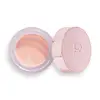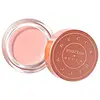What's inside
What's inside
 Key Ingredients
Key Ingredients

 Benefits
Benefits

 Concerns
Concerns

 Ingredients Side-by-side
Ingredients Side-by-side

Paraffinum Liquidum
EmollientPolyisobutene
Hydrogenated Polyisobutene
EmollientPentaerythrityl Tetraisostearate
EmollientHydrogenated Microcrystalline Wax
Emulsion StabilisingPolyglyceryl-3 Diisostearate
EmulsifyingBis-Diglyceryl Polyacyladipate-2
EmollientSilica
AbrasiveParaffin
PerfumingGlyceryl Stearate Se
EmulsifyingCera Microcristallina
Emulsion StabilisingPhenoxyethanol
PreservativeSimmondsia Chinensis Seed Oil
EmollientVitis Vinifera Seed Oil
EmollientTocopheryl Acetate
AntioxidantTocopherol
AntioxidantBHT
AntioxidantCI 77891
Cosmetic ColorantCI 77499
Cosmetic ColorantCI 77491
Cosmetic ColorantCI 77492
Cosmetic ColorantParaffinum Liquidum, Polyisobutene, Hydrogenated Polyisobutene, Pentaerythrityl Tetraisostearate, Hydrogenated Microcrystalline Wax, Polyglyceryl-3 Diisostearate, Bis-Diglyceryl Polyacyladipate-2, Silica, Paraffin, Glyceryl Stearate Se, Cera Microcristallina, Phenoxyethanol, Simmondsia Chinensis Seed Oil, Vitis Vinifera Seed Oil, Tocopheryl Acetate, Tocopherol, BHT, CI 77891, CI 77499, CI 77491, CI 77492
Ricinus Communis Seed Oil
MaskingPolybutene
Rhus Verniciflua Peel Wax
Kaolin
AbrasiveC12-15 Alkyl Benzoate
AntimicrobialCI 77120
Cosmetic ColorantHelianthus Annuus Seed Oil
EmollientSqualane
EmollientHydrogenated Polycyclopentadiene
Trihydroxystearin
Skin ConditioningSodium Lauroyl Aspartate
CleansingAluminum Hydroxide
EmollientSorbitan Sesquioleate
EmulsifyingIsopropyl Titanium Triisostearate
EmollientZinc Chloride
AntimicrobialCaprylyl Glycol
EmollientHexylene Glycol
EmulsifyingTocopherol
AntioxidantAscorbyl Palmitate
AntioxidantTocopheryl Acetate
AntioxidantTetrahexyldecyl Ascorbate
AntioxidantPhenoxyethanol
PreservativeMica
Cosmetic ColorantCI 77891
Cosmetic ColorantCI 77491
Cosmetic ColorantCI 77492
Cosmetic ColorantCI 77499
Cosmetic ColorantCI 77000
Cosmetic ColorantCI 77400
Cosmetic ColorantCI 77163
Cosmetic ColorantCI 77288
Cosmetic ColorantCI 77289
Cosmetic ColorantCI 77510
Cosmetic ColorantCI 77742
Cosmetic ColorantCI 77007
Cosmetic ColorantCI 42090
Cosmetic ColorantCI 19140
Cosmetic ColorantRicinus Communis Seed Oil, Polybutene, Rhus Verniciflua Peel Wax, Kaolin, C12-15 Alkyl Benzoate, CI 77120, Helianthus Annuus Seed Oil, Squalane, Hydrogenated Polycyclopentadiene, Trihydroxystearin, Sodium Lauroyl Aspartate, Aluminum Hydroxide, Sorbitan Sesquioleate, Isopropyl Titanium Triisostearate, Zinc Chloride, Caprylyl Glycol, Hexylene Glycol, Tocopherol, Ascorbyl Palmitate, Tocopheryl Acetate, Tetrahexyldecyl Ascorbate, Phenoxyethanol, Mica, CI 77891, CI 77491, CI 77492, CI 77499, CI 77000, CI 77400, CI 77163, CI 77288, CI 77289, CI 77510, CI 77742, CI 77007, CI 42090, CI 19140
 Reviews
Reviews

Ingredients Explained
These ingredients are found in both products.
Ingredients higher up in an ingredient list are typically present in a larger amount.
Ci 77491 is also hydrated iron III oxide. It's sole purpose is to give a red/pink hue to products.
Iron III oxides are classified as inorganic chemicals for coloring.
Synthetically created Ci 77491 is considered safer than those naturally found. This is because the synthetically created version may contain less impurities. Iron oxides are generally non-toxic and non-allergenic.
Learn more about CI 77491Ci 77492 is also hydrated iron III oxide. It's sole purpose is to give a yellow hue to products.
Iron III oxides are classified as inorganic chemicals for coloring.
Synthetically created Ci 77492 is considered safer than those naturally found. This is because the synthetically created version may contain less impurities. Iron oxides are generally non-toxic and non-allergenic.
Learn more about CI 77492Ci 77499 is also hydrated iron III oxide. It is created from mixing red and black iron oxides. This helps give shades of darkness to a product.
Iron III oxides are classified as inorganic chemicals for coloring.
Ci 77891 is a white pigment from Titanium dioxide. It is naturally found in minerals such as rutile and ilmenite.
It's main function is to add a white color to cosmetics. It can also be mixed with other colors to create different shades.
Ci 77891 is commonly found in sunscreens due to its ability to block UV rays.
Learn more about CI 77891Phenoxyethanol is a preservative that has germicide, antimicrobial, and aromatic properties. Studies show that phenoxyethanol can prevent microbial growth. By itself, it has a scent that is similar to that of a rose.
It's often used in formulations along with Caprylyl Glycol to preserve the shelf life of products.
Tocopherol (also known as Vitamin E) is a common antioxidant used to help protect the skin from free-radicals and strengthen the skin barrier. It's also fat soluble - this means our skin is great at absorbing it.
Vitamin E also helps keep your natural skin lipids healthy. Your lipid skin barrier naturally consists of lipids, ceramides, and fatty acids. Vitamin E offers extra protection for your skin’s lipid barrier, keeping your skin healthy and nourished.
Another benefit is a bit of UV protection. Vitamin E helps reduce the damage caused by UVB rays. (It should not replace your sunscreen). Combining it with Vitamin C can decrease sunburned cells and hyperpigmentation after UV exposure.
You might have noticed Vitamin E + C often paired together. This is because it is great at stabilizing Vitamin C. Using the two together helps increase the effectiveness of both ingredients.
There are often claims that Vitamin E can reduce/prevent scarring, but these claims haven't been confirmed by scientific research.
Learn more about TocopherolTocopheryl Acetate is AKA Vitamin E. It is an antioxidant and protects your skin from free radicals. Free radicals damage the skin by breaking down collagen.
One study found using Tocopheryl Acetate with Vitamin C decreased the number of sunburned cells.
Tocopheryl Acetate is commonly found in both skincare and dietary supplements.
Learn more about Tocopheryl Acetate